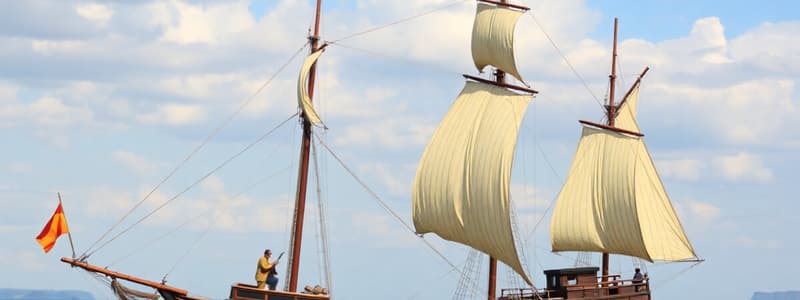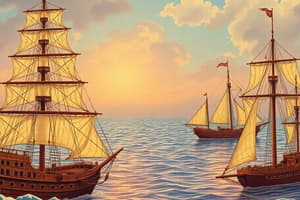Podcast
Questions and Answers
The Columbian Exchange refers to the transfer of plants, animals, and diseases between the Eastern and Western Hemispheres.
The Columbian Exchange refers to the transfer of plants, animals, and diseases between the Eastern and Western Hemispheres.
True (A)
European colonization of the Americas led to a decrease in indigenous populations due to diseases like malaria, smallpox and measles.
European colonization of the Americas led to a decrease in indigenous populations due to diseases like malaria, smallpox and measles.
True (A)
American foods had little impact on the nutritional diversity of Afro-Eurasia.
American foods had little impact on the nutritional diversity of Afro-Eurasia.
False (B)
Asian states universally embraced European-dominated long-distance trade without reservation.
Asian states universally embraced European-dominated long-distance trade without reservation.
The expansion of maritime trading networks solely benefited European states, with no impact on African kingdoms.
The expansion of maritime trading networks solely benefited European states, with no impact on African kingdoms.
Existing trade networks in the Indian Ocean declined completely due to the arrival of the Portuguese, Spanish and Dutch merchants.
Existing trade networks in the Indian Ocean declined completely due to the arrival of the Portuguese, Spanish and Dutch merchants.
Colonial economies in the Americas depended solely on newly introduced labor systems, disregarding existing systems.
Colonial economies in the Americas depended solely on newly introduced labor systems, disregarding existing systems.
The growth of the plantation economy in the Americas decreased the demand for enslaved labor.
The growth of the plantation economy in the Americas decreased the demand for enslaved labor.
Mercantilist policies encouraged free trade between European colonies and other nations.
Mercantilist policies encouraged free trade between European colonies and other nations.
The flow of silver from Spanish colonies played a crucial role in global trade, particularly in purchasing Asian goods.
The flow of silver from Spanish colonies played a crucial role in global trade, particularly in purchasing Asian goods.
The Atlantic trading system only involved the movement of goods and wealth, excluding the forced migration of enslaved persons.
The Atlantic trading system only involved the movement of goods and wealth, excluding the forced migration of enslaved persons.
Increased interactions between hemispheres had no impact to the spread of existing religions.
Increased interactions between hemispheres had no impact to the spread of existing religions.
The Mughal and Ottoman empires never adopted practices to accommodate ethnic and religious diversity.
The Mughal and Ottoman empires never adopted practices to accommodate ethnic and religious diversity.
Imperial conquests had no effect on the formation of new political and economic elites.
Imperial conquests had no effect on the formation of new political and economic elites.
The power of existing political and economic elites remained constant throughout the period of imperial expansion.
The power of existing political and economic elites remained constant throughout the period of imperial expansion.
Land empires, such as the Mughal and Ottoman, saw a decrease in their spheres of influence due to a lack of technological advancements.
Land empires, such as the Mughal and Ottoman, saw a decrease in their spheres of influence due to a lack of technological advancements.
Rulers never utilized religious ideas, art, and monumental architecture to legitimize their rule.
Rulers never utilized religious ideas, art, and monumental architecture to legitimize their rule.
Rulers relied solely on donations to generate revenue, avoiding taxation.
Rulers relied solely on donations to generate revenue, avoiding taxation.
The Protestant Reformation did not affect the growth of Christianity.
The Protestant Reformation did not affect the growth of Christianity.
Political rivalries between the Ottoman and Safavid empires diffused tensions within Islam between Sunni and Shi’a.
Political rivalries between the Ottoman and Safavid empires diffused tensions within Islam between Sunni and Shi’a.
Flashcards
Maritime Innovations
Maritime Innovations
New tools, ship designs, and understanding of wind and currents that enabled transoceanic travel and trade.
Transoceanic Exploration
Transoceanic Exploration
State-funded voyages that spurred travel and trade.
Portuguese Maritime Empire
Portuguese Maritime Empire
Portuguese dominance in maritime tech leading to trade & a global trading-post empire.
Spanish Sponsorship
Spanish Sponsorship
Signup and view all the flashcards
Northern Atlantic Crossings
Northern Atlantic Crossings
Signup and view all the flashcards
Columbian Exchange
Columbian Exchange
Signup and view all the flashcards
Disease Transfer
Disease Transfer
Signup and view all the flashcards
Impact of American Foods
Impact of American Foods
Signup and view all the flashcards
European Trading Posts
European Trading Posts
Signup and view all the flashcards
Asian Trade Restrictions
Asian Trade Restrictions
Signup and view all the flashcards
Maritime Empires
Maritime Empires
Signup and view all the flashcards
Growth of African States
Growth of African States
Signup and view all the flashcards
Colonial Economies
Colonial Economies
Signup and view all the flashcards
Coerced Labor Systems
Coerced Labor Systems
Signup and view all the flashcards
Plantation Economy Effects
Plantation Economy Effects
Signup and view all the flashcards
Mercantilist Policies
Mercantilist Policies
Signup and view all the flashcards
Atlantic Trading System
Atlantic Trading System
Signup and view all the flashcards
Labor Intensification
Labor Intensification
Signup and view all the flashcards
Cultural Synthesis
Cultural Synthesis
Signup and view all the flashcards
Religious Syncretism
Religious Syncretism
Signup and view all the flashcards
Study Notes
- New tools, ship designs, and understanding of wind and current patterns enabled transoceanic travel and trade.
- State-supported transoceanic maritime exploration increased.
Portuguese Exploration
- Portuguese maritime technology and navigation skills led to increased travel and trade with Africa and Asia.
- Resulted in a global trading-post empire.
Spanish Exploration
- Spanish sponsorship of Columbus' voyages and subsequent voyages across the Atlantic and Pacific dramatically increased European interest in transoceanic travel and trade.
Northern Atlantic Crossings
- Undertaken under English, French, and Dutch sponsorship.
- Often with the goal of finding alternative sailing routes to Asia.
Columbian Exchange
- New connections between the Eastern and Western Hemispheres resulted in the exchange of new plants, animals, and diseases, known as the Columbian Exchange.
- European colonization of the Americas led to the unintentional transfer of disease vectors.
- Mosquitoes and rats spread diseases that were endemic in the Eastern Hemisphere, including smallpox, measles, and malaria.
- Diseases substantially reduced indigenous populations, with catastrophic effects in many areas.
- American foods became staple crops in Europe, Asia, and Africa.
- Cash crops were grown primarily on plantations with coerced labor and were exported mostly to Europe and the Middle East.
- Afro-Eurasian fruit trees, grains, sugar, and domesticated animals were brought by Europeans to the Americas.
- Other foods were brought by African enslaved persons.
- Populations in Afro-Eurasia benefitted nutritionally from the increased diversity of American food crops.
- New trading posts established in Africa and Asia proved profitable for rulers and merchants involved in new global trade networks.
- Some Asian states sought to limit the disruptive effects of European-dominated trade by adopting restrictive or isolationist trade policies.
- Largely driven by political, religious, and economic rivalries, European states established new maritime empires.
- Empires included the Portuguese, Spanish, Dutch, French, and British.
- Expansion of maritime trading networks fostered the growth of states in Africa.
- The Asante and the Kingdom of the Kongo increased influence through participation in trading networks.
- Existing trade networks in the Indian Ocean continued to flourish.
- Included intra-Asian trade and Asian merchants, despite disruption due to Portuguese, Spanish, and Dutch merchants.
- Colonial economies in the Americas largely depended on agriculture.
- Utilized existing labor systems, including the Incan mit’a.
- Introduced new labor systems including chattel slavery, indentured servitude, and encomienda and hacienda systems.
- Enslavement in Africa continued in its traditional forms.
- Included incorporation of enslaved persons into households and the export of enslaved persons to the Mediterranean and the Indian Ocean regions.
- Growth of the plantation economy increased demand for enslaved labor in the Americas.
- Led to significant demographic, social, and cultural changes.
- Mercantilist policies and practices were used by European rulers to expand and control their economies.
- Joint-stock companies, influenced by these mercantilist principles, were used by rulers and merchants to finance exploration and were used by rulers to compete against one another in global trade.
- Economic disputes led to rivalries and conflict between states.
- The Atlantic trading system involved the movement of goods, wealth, and labor, including enslaved persons.
- The new global circulation of goods was facilitated by chartered European monopoly companies and the global flow of silver, especially from Spanish colonies in the Americas.
- Silver was used to purchase Asian goods for the Atlantic markets and satisfy Chinese demand for silver.
- Regional markets continued to flourish in Afro-Eurasia by using established commercial practices and new transoceanic and regional shipping services developed by European merchants.
- Peasant and artisan labor continued and intensified in many regions as the demand for food and consumer goods increased.
- Demographic changes in Africa resulted from the trade of enslaved persons.
- The Atlantic trading system involved the movement of labor—including enslaved persons and the mixing of African, American, and European cultures and peoples, with all parties contributing to this cultural synthesis.
- Interactions between newly connected hemispheres expanded religions, and contributed to religious conflicts and the development of syncretic belief systems and practices.
- State expansion and centralization led to resistance from an array of social, political, and economic groups on a local level.
- Enslaved persons challenged existing authorities in the Americas through organized resistance.
- Many states, such as the Mughal and Ottoman empires, adopted practices to accommodate the ethnic and religious diversity of their subjects or to utilize the economic, political, and military contributions of different ethnic or religious groups.
- In other cases, states suppressed diversity or limited certain groups’ roles in society, politics, or the economy.
- Imperial conquests and widening global economic opportunities contributed to the formation of new political and economic elites.
- Included in China with the transition to the Qing Dynasty and in the Americas with the rise of the Casta system.
- The power of existing political and economic elites fluctuated.
- Elites confronted new challenges to their ability to affect the policies of the increasingly powerful monarchs and leaders.
- Imperial expansion relied on the increased use of gunpowder, cannons, and armed trade.
- Used to establish large empires in both hemispheres.
- Land empires included the Manchu in Central and East Asia, the Mughal in South and Central Asia, the Ottoman in Southern Europe, the Middle East, and North Africa, and the Safavids in the Middle East.
- Political and religious disputes led to rivalries and conflict between states.
- Recruitment and use of bureaucratic elites and the development of military professionals became more common.
- Used by rulers to maintain centralized control over their populations and resources.
- Rulers continued to use religious ideas, art, and monumental architecture to legitimize their rule.
- Rulers used tribute collection, tax farming, and innovative tax-collection systems to generate revenue.
- Used in order to forward state power and expansion.
- The Protestant Reformation marked a break with existing Christian traditions.
- Both the Protestant and Catholic reformations contributed to the growth of Christianity.
- Political rivalries between the Ottoman and Safavid empires intensified the split within Islam between Sunni and Shi’a.
- Sikhism developed in South Asia in a context of interactions between Hinduism and Islam.
- Knowledge, scientific learning, and technology from the Classical, Islamic, and Asian worlds spread.
- Facilitated European technological developments and innovation.
Studying That Suits You
Use AI to generate personalized quizzes and flashcards to suit your learning preferences.





